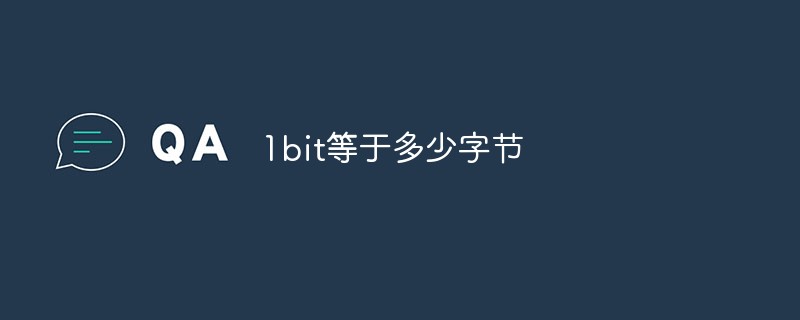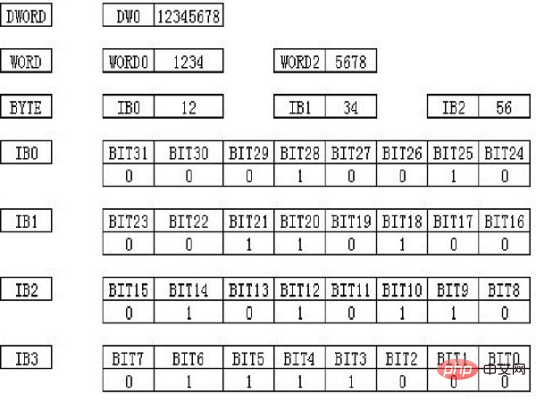1 bit equals how many bytes
1bit is equal to one-eighth of a byte. In the binary number system, each 0 or 1 is a bit (bit), and a bit is the smallest unit of data storage; every 8 bits (bit, abbreviated as b) constitute a byte (Byte), so "1 byte ( Byte) = 8 bits”. In most computer systems, a byte is an 8-bit (bit) long data unit. Most computers use a byte to represent a character, number, or other character.

The operating environment of this tutorial: Windows 7 system, Dell G3 computer.
1bit is equal to one-eighth of a byte.
1 byte is 8 bits (bit), that is: 1byte = 8bit.
bit (Binary digit, bit), a computer terminology, is a unit of information; it is also a bit in a binary number , a unit of measurement of information. smallest unit. Information necessary to reduce the number of stimulus alternatives by half in situations where a different choice is required. That is, the information amount (number of bits) of the signal is equal to the logarithm of the signal stimulus amount with base 2. L. Hartley believed in 1928 that logarithmic units are most appropriate to measure the amount of information.
In the binary number system, each 0 or 1 is a bit, and a bit is the smallest unit of data storage. Among them, 8bit is called a byte (Byte) . The number of CPU bits in a computer refers to the maximum number of bits that the CPU can process at one time. For example, the CPU of a 32-bit computer can handle up to 32 bits of data at a time.

Data storage is in "byte" (Byte) as the unit, and data transmission is mostly in "bit" (bit, also known as "bit").A bit represents a 0 or 1 (i.e. binary), and every 8 bits (bit, abbreviated as b) constitute a byte (Byte, abbreviated as B) , which is the smallest level of information unit.
In most computer systems, a byte is an 8-bit long data unit. Most computers use a byte to represent a character, number, or other character. A byte can also represent a series of binary bits. In some computer systems, 4 bytes represent a word, which is the unit of data that the computer can efficiently process when executing instructions. Some language descriptions require 2 bytes to represent a character, which is called a double-byte character set. Some processors are capable of handling double-byte or single-byte instructions.
Unit conversion
Information storage is a measure of the amount of programs and data stored in memory. Its main unit of measurement is bytes, with 1 byte (Byte) equal to 8 bits (b) binary. Bit (Binary Digits): stores a binary number, that is, 0 or 1, which is the smallest storage unit. 8 binary digits are a byte unit. An English letter (regardless of case) occupies one byte of space, and a Chinese character occupies two bytes of space. English punctuation occupies one byte, and Chinese punctuation occupies two bytes
1 byte (Byte) = 8 bits (bit)
1KB(Kilobyte, kilobyte)=1024B
1MB(Megabyte, megabyte)=1024KB
1GB(Gigabyte, Jizi Trillionbyte, gigabyte)=1024MB
1TB(Trillionbyte, terabyte)=1024GB
1PB(Petabyte, Exabyte, petabyte) = 1024TB
- ##1EB(Exabyte, exabyte) = 1024PB
- 1ZB(Zettabyte, ten trillion bytes, zettabytes) = 1024EB
- 1YB(Yotabyte, one hundred trillion bytes, yaobytes) = 1024ZB
- 1BB(Brontobyte, billions of billions of bytes)=1024YB
Extended knowledge:
bit (Binary digit, bit) has two concepts
- A computer terminology, it is a unit of information and is a transliteration of English BIT. The information contained in one bit of a binary number is one bit. For example, the binary number 0100 is 4 bits.
- The bit in a binary number is the measurement unit of information and is the smallest unit of information. The data in the digital file is represented by binary, "1" represents the pulse signal, and "0" represents the pulse interval. If the information of each point on the waveform is represented by a code of four bits, it is called 4 bits. The higher the number of bits, the more accurately the analog signal is expressed and the stronger the ability to restore the picture.
Bit difference
According to Nyquist's sampling theory, sufficient sampling frequency is required to completely restore a signal. He believes that to turn an analog signal into a discrete symbol (Discrete Time), the sampling frequency must be at least twice the original signal. Sampling is the first step in converting analog signals into digital signals, but the precision is still too rough, so the technology of super-sampling emerged. Generally, supersampling means increasing the spatial frequency and sampling more densely. On the one hand, it improves the accuracy. On the other hand, the analog signal generated after image processing is relatively complete. The required number and slope of the low-pass filter (to filter out picture noise) are both. It can be significantly reduced and picture distortion will also be greatly improved. However, after supersampling, there will be many gaps between samples. At this time, some inserted samples are needed to maintain signal integrity, and this task falls on the Digital Graphic Filter. The more advanced design uses GPU (Graphic Processing Unit) calculations to obtain a smooth curve with ultra-high sampling, such as Krell's 64 times super-sampling, but only Theta, Wadia, Krell, and Vimak have such technology. Another type of digital filtering is to integrate complex programs into the chip in advance to have GPU-like functions. Japan's Denon and Pioneer both have such designs. The most common method is to use mass-produced chips. NPC and Burr-Brown have finished products available. Of course, the effect will be subject to some limitations.
After digital filtering, it enters the display. From here on, there is a difference between single bit and multi-bit. Multi-bit is a digital signal that passes through a current divider (Current Switch) and becomes current outputs of different sizes. Because the digital signal is a binary relationship, the current of the DAC is also arranged in multiples of 1, 2, 4, and 8. Each bit controls a power distributor respectively. As the image signal changes, the output current also changes. Next is a very fast I/V conversion circuit to convert these currents into voltages, which are then low-pass filtered. The complete image signal appears. A twenty-bit DAC has a output current change of 1,048,576, which is quite high resolution. The most commonly used twenty-bit chips are Burr-Brown's PCM-63 and improved PCM-1702. The most expensive is probably the Ultra-Analog module.
For more related knowledge, please visit the FAQ column!
The above is the detailed content of 1 bit equals how many bytes. For more information, please follow other related articles on the PHP Chinese website!

Hot AI Tools

Undresser.AI Undress
AI-powered app for creating realistic nude photos

AI Clothes Remover
Online AI tool for removing clothes from photos.

Undress AI Tool
Undress images for free

Clothoff.io
AI clothes remover

Video Face Swap
Swap faces in any video effortlessly with our completely free AI face swap tool!

Hot Article

Hot Tools

Notepad++7.3.1
Easy-to-use and free code editor

SublimeText3 Chinese version
Chinese version, very easy to use

Zend Studio 13.0.1
Powerful PHP integrated development environment

Dreamweaver CS6
Visual web development tools

SublimeText3 Mac version
God-level code editing software (SublimeText3)

Hot Topics
 1387
1387
 52
52
 1MB of storage capacity is equivalent to how many bytes
Mar 03, 2023 pm 05:42 PM
1MB of storage capacity is equivalent to how many bytes
Mar 03, 2023 pm 05:42 PM
1MB of storage capacity is equivalent to 2 to the 20th power bytes, or 1,048,576 bytes. MB is a storage unit in computers, pronounced as "mega"; because 1MB is equal to 1024KB, and 1KB is equal to 1024B (bytes), so 1MB is equal to 1048576 (1024 *1024) bytes.
 How many bytes does 128mb mean?
Nov 29, 2022 am 10:35 AM
How many bytes does 128mb mean?
Nov 29, 2022 am 10:35 AM
128mb refers to 134217728 bytes; the byte conversion formula is "1MB=1024KB=1048576B=8388608bit", which means that 1048576 English letters and 524288 Chinese characters can be saved; the traffic unit conversion formula is 1GB=1024MB, 1MB=1024KB, 1KB= 1024B.
 1 bit equals how many bytes
Mar 09, 2023 pm 03:11 PM
1 bit equals how many bytes
Mar 09, 2023 pm 03:11 PM
1 bit is equal to one-eighth of a byte. In the binary number system, each 0 or 1 is a bit (bit), and a bit is the smallest unit of data storage; every 8 bits (bit, abbreviated as b) constitute a byte (Byte), so "1 byte ( Byte) = 8 bits”. In most computer systems, a byte is an 8-bit (bit) long data unit. Most computers use a byte to represent a character, number, or other character.
 How many bytes does one ascii character occupy?
Mar 09, 2023 pm 03:49 PM
How many bytes does one ascii character occupy?
Mar 09, 2023 pm 03:49 PM
One ascii character occupies 1 byte. ASCII code characters are represented by 7-bit or 8-bit binary encoding in the computer and are stored in one byte, that is, one ASCII code occupies one byte. ASCII code can be divided into standard ASCII code and extended ASCII code. Standard ASCII code is also called basic ASCII code. It uses 7-bit binary numbers (the remaining 1 binary digit is 0) to represent all uppercase and lowercase letters, and the numbers 0 to 9. Punctuation marks, and special control characters used in American English.
 How many bytes do utf8 encoded Chinese characters occupy?
Feb 21, 2023 am 11:40 AM
How many bytes do utf8 encoded Chinese characters occupy?
Feb 21, 2023 am 11:40 AM
UTF8 encoded Chinese characters occupy 3 bytes. In UTF-8 encoding, one Chinese character is equal to three bytes, and one Chinese punctuation mark occupies three bytes; while in Unicode encoding, one Chinese character (including traditional Chinese) is equal to two bytes. UTF-8 uses 1~4 bytes to encode each character. One US-ASCIl character only needs 1 byte to encode. Latin, Greek, Cyrillic, Armenian, and Hebrew with diacritical marks. , Arabic, Syriac and other letters require 2-byte encoding.
 How many bytes does an ascii code occupy?
Sep 07, 2023 pm 04:03 PM
How many bytes does an ascii code occupy?
Sep 07, 2023 pm 04:03 PM
An ASCII code occupies one byte. ASCII code is a coding standard used to represent characters. It uses 7-bit binary numbers to represent 128 different characters, including letters, numbers, punctuation marks, special characters, etc. A byte is the basic unit of computer storage unit. It consists of 8 binary bits. Each binary bit can be 0 or 1. One byte can represent 256 different values, so it can represent all characters in the ASCII code.
 Detailed explanation of the method of converting int type to bytes in PHP
Mar 06, 2024 pm 06:18 PM
Detailed explanation of the method of converting int type to bytes in PHP
Mar 06, 2024 pm 06:18 PM
Detailed explanation of the method of converting int type to byte in PHP In PHP, we often need to convert the integer type (int) to the byte (Byte) type, such as when dealing with network data transmission, file processing, or encryption algorithms. This article will introduce in detail how to convert the int type to the byte type and provide specific code examples. 1. The relationship between int type and byte In the computer field, the basic data type int represents an integer, while byte (Byte) is a computer storage unit, usually 8-bit binary data
 4kb indicates how many bytes there are in the storage unit
Feb 28, 2023 pm 12:12 PM
4kb indicates how many bytes there are in the storage unit
Feb 28, 2023 pm 12:12 PM
4KB means that the storage unit is 4096 bytes. KB refers to kilobyte, which is a multiple form of computer data storage unit byte. A kilobyte is based on the power of 2, that is, a kilobyte (1KB) is equal to 1024 bytes (B ); therefore "4KB=4*1024B=4096B", that is, 4KB represents 4096 bytes.



